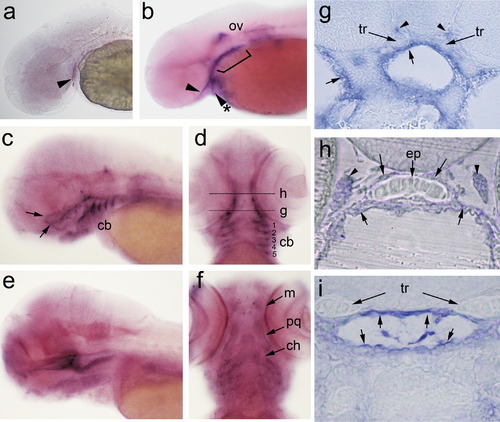Fig. 2
- ID
- ZDB-FIG-110318-36
- Publication
- Curtin et al., 2011 - Zebrafish wnt9a is expressed in pharyngeal ectoderm and is required for palate and lower jaw development
- Other Figures
- All Figure Page
- Back to All Figure Page
|
Expression of wnt9a in pharyngeal arch and oropharyngeal epithelium. Whole-mount RNA in situ hybridization of wnt9a at 36 hpf (a), 48 hpf (b), 3 dpf (c, d, g and h), and 4 dpf (e, f and i). Embryos are oriented with head toward the left in lateral views (a–c and e) and head toward the top in ventral views (d and f) and sections (g–i). Sections are shown in 10× (g), and 40× (h and i) magnification. The levels of the sections shown in panels (g) and (h) are indicated in panel (d), and the level in panel (i) is indicated in (e). The wnt9a transcripts can be detected in the developing pharyngeal arches (arrow, a) as paired cell clusters. At 48 hpf, wnt9a expression is detected in the first pharyngeal arch, as it splits to dorsal (b, arrow) and ventral (b, arrow with asterisk) regions. There is also wnt9a expression along the posterior pharyngeal arch cells (c, bracket), and the otic vesicle (ov). By 3 dpf, facial skeletal structures have formed, where wnt9a expression can be detected surrounding the ethmoid plate (ep), trabeculae (tr), and lower jaw structures, including the five paired ceratobrachials (cb, 1–5). To better visualize this weak whole-mount staining, plastic sections were performed (g and h). Cross-section analysis reveals wnt9a expression in the oral epithelium along the roof and the floor of the oropharynx (g, arrow), and along the surface epithelium ventral to the lower jaw (g, arrow with asterisk). The ethmoid plate is surrounded by wnt9a expressing cells, bordered by the roof of the oropharynx below, and a single cell-layer of wnt9a expressing cells above (h, arrows). There are also clusters of wnt9a expressing cells laterally that may represent ocular muscle or optic nerve structure (h, arrowheads). Expression of wnt9a persists into 4 dpf along the oropharynx and continues into the foregut (e), detected in the epithelium that lines the oropharynx circumferentially (i). There is also weak wnt9a expression outlining the skeletal structures, such as Meckel’s cartilage (m), palatoquadrate (pq) and the ceratohyal (ch). Abbreviations: cb, ceratobrachial; ch, ceratohyal; ep, ethmoid plate; m, Meckel’s cartilage; ov, otic vesicle; pq, palatoquadrate; tr, trabeculae. |
| Gene: | |
|---|---|
| Fish: | |
| Anatomical Terms: | |
| Stage Range: | Prim-25 to Day 4 |
Reprinted from Mechanisms of Development, 128(1-2), Curtin, E., Hickey, G., Kamel, G., Davidson, A.J., and Liao, E.C., Zebrafish wnt9a is expressed in pharyngeal ectoderm and is required for palate and lower jaw development, 104-115, Copyright (2011) with permission from Elsevier. Full text @ Mech. Dev.

